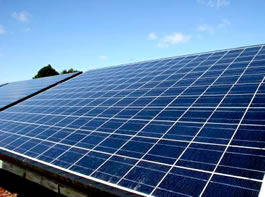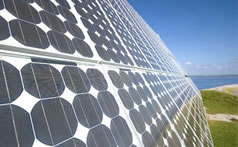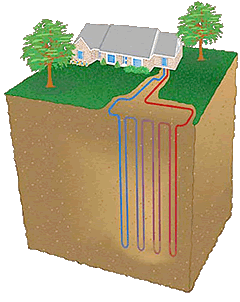Sustainable Energies
In the current economic and ecological climate the desire to replace fossil based energy sources and technologies in the home has grown hugely. We have prepared these pages to give you an introduction into the methods that we currently recommend and supply to our customers and that we would recommend to everyone considering building, renovating or extending their own home.
Solar Energy
Three basic approaches are used today to gain maximum benefit of solar energy in buildings. The first is known as passive solar which is an architectural approach that uses the building material, orientation and general design to ensure that solar gains are maximised. Therefore, the approach is of most applicability to buildings that are in the design and planning stage, although minor retrofits, for example the addition of a south facing conservatory, can be made to existing buildings. Passive solar design can significantly reduce the need for auxiliary heating and lighting, it need add nothing to the cost of the building and generally produces a pleasant and healthy living environment, which will increase the amenity value of the building.

A second type of solar system, sometimes known as active solar technology, involves the installation of a solar collector device, which is typically a metal box structure containing an absorber. The solar collector absorbs the sun’s heat to provide space or, more commonly, water heating. For water heating, three basic types of solar collector are available - flat plate, evacuated tube and air - based systems. For Space Heating, it is possible to use air rather than water as the heat transfer fluid for applications where space heating is the main requirement. A whole house system currently being marketed in Ireland incorporates triple glazed solar collectors, an air handling unit and a ducted warm air ventilation supply. Heat is reclaimed from returned air by a heat exchanger system. During the summer, the system provides the bulk of hot water, and a conventional boiler provides back up in cloudy, winter weather.
 The third approach is solar photovoltaic systems which use semiconductor materials to convert solar energy to electricity. Photovoltaic cells are used widely in consumer products such as solar calculators, watches and other electronic systems, and standalone photovoltaic systems are being used increasingly in regions where small amounts of electricity are required in areas remote from the grid. In buildings, there is potential to integrate photovoltaic materials into roof and wall structures with minimum visual impact. The photovoltaic system can then be linked to the electricity distribution network through an inverter. When the sun shines, the installation provides the building with electricity and any surplus power is fed into the network; when sunshine is insufficient, electricity is supplied from the grid.
The third approach is solar photovoltaic systems which use semiconductor materials to convert solar energy to electricity. Photovoltaic cells are used widely in consumer products such as solar calculators, watches and other electronic systems, and standalone photovoltaic systems are being used increasingly in regions where small amounts of electricity are required in areas remote from the grid. In buildings, there is potential to integrate photovoltaic materials into roof and wall structures with minimum visual impact. The photovoltaic system can then be linked to the electricity distribution network through an inverter. When the sun shines, the installation provides the building with electricity and any surplus power is fed into the network; when sunshine is insufficient, electricity is supplied from the grid. When solar energy is used instead of traditionally generated electricity or fossil fuels such as oil, coal and gas, the release of gases that cause global climate change, acid rain and air pollution is reduced.
In addition to helping protect the environment, maximising the use of solar energy in a house through passive solar design can make economic sense through reduced fuel and electricity bills.
Geo-Thermal
When we think of energy for running the home we automatically think of oil, gas, electricity and fossil fuel, but we have all of the free energy we need from the earth, we just have to know how to convert it for our own use. There are other options like Solar energy , Wind Energy and one that most people have not heard of or do not understand called Geo-thermal energy.

Basically, “Geo” means earth and “thermal” means heat. so when we talk about Geo- Thermal energy we mean earth heat. In most ground the first ten feet below ground level stays at a constant temperature of between 10 and 16 degrees F. If you choose to use a ground source heat pump you can convert this energy to heat your home. Pipes are buried in the ground near the house. Inside the pipes is a fluid like anti freeze, like in a car radiator, this gets circulated around the pipes by a pump. In the winter the heat from the warm ground goes through the heat exchanger of the heat pump which sends warm air into the house. During hot weather the process is reversed, hot air from the inside of the building goes through the heat exchanger and the heat passes into relatively cooler ground.
Free heat from the garden?
Heat is widely available in the ground, air and water around your house. These natural sources of heat are constantly replenished by the sun, wind and rain. A heat pump system will harness these free and renewable energy source for heating your house and supply hot water at a very low cost. The role of the heat pump is to ‘pump up’ heat from a low temperature source, for example the ground under your lawn and release it at a higher temperature into your central heating system.
Ok. But why is it so economical?
Because at least 70% of your heat will come from a free source. For every unit of electricity used to drive the heat pump, 3 to 5 units of useful heat will be generated. Manufacturers generally refer to the ratio between the useful heat produced and the electricity used as the coefficient of performance. With an overall energy efficiency in excess of 400%, compared to 70 to 85% efficiency for a good oil or gas boiler, no wonder a heat pump is so economical.
And good for the environment
When driven with conventional electricity, a heat pump system emits 40% less CO2 emissions than a boiler. That’s a great contribution to the fight against climate change. But if you can operate your heat pump with green electricity (e.g wind farm) then your central heating system becomes 100% renewable and totally free of greenhouse gases emissions.
So, is it really worth it?
Absolutely. While they are more expensive initially to install compared to a conventional oil system, their frugality in electricity will save you 20,000 Euro over its lifetime.
In effect you only have to use a small amount of electricity to bring this energy out of the ground. This could be supplied by battery back up energy which has been captured by either Solar energy or Wind Energy which means no heating or electricity bills once the initial outlay has been made.
Wind Energy
 You can not get away from the wind in Ireland so why not use it to your own advantage and turn free wind into free electricity?
You can not get away from the wind in Ireland so why not use it to your own advantage and turn free wind into free electricity? Over the past decade in Ireland wind farms have started to spring up as the government looks for alternative ways to produce cheaper move environmental friendly energy.
We all know about the Windmills in Holland but they give the wrong impression on the size of a windmill that would be require to run a house or small business.
But just how is that electricity produced?
 Blowing wind spins the blades on a wind turbine - just like a toy pinwheel. This device is called a wind turbine not a windmill. The blades on the turbine are attached to a hub that is mounted on a turning shaft. The shaft goes through a gear transmission that is attached to a high speed shaft which turns the generator that makes electricity. If the wind gets too high the turbine has a brake that will keep the blades from turning too fast and being damaged.
Blowing wind spins the blades on a wind turbine - just like a toy pinwheel. This device is called a wind turbine not a windmill. The blades on the turbine are attached to a hub that is mounted on a turning shaft. The shaft goes through a gear transmission that is attached to a high speed shaft which turns the generator that makes electricity. If the wind gets too high the turbine has a brake that will keep the blades from turning too fast and being damaged. When considering the different options it is important to remember that wind turbines work efficiently when the wind speed is above 12 to 14 mile per hour . Wind has to be at this speed to turn the turbines fast enough to generated electricity.
A single wind turbine can produce about 50 to 300 kilowatts of electricity. A kilowatt is 1,000 watts ( kilo means 1,000 ). You can light ten 100 watt light bulb’s with 1,000 watts. So a 3,000 kilowatt wind turbine could light up to 3,000 light bulb’s that use 100 watts each. This should quite easily be enough to run a house or small office. The change in planning regulations since June 2008 have reduced the barriers to entry on such a system.
Sustainable Energy Ireland: “Wind is a clean source of energy. Unlike fossil fuel combustion, wind power can be harnessed without the release of chemical emissions. In fact, every unit of electricity produced from wind rather than traditional fossil fuel generation prevents significant emissions of carbon dioxide, sulphur dioxide and nitrogen oxides - gases that cause global warming, acid rain and air pollution.”
|
Some grants are available for these energy technologies. At Andrew Lawless Construction we can provide you with these technologies as part of your home build or if your home is already built we can help you replace your existing system later on in the day. |
||